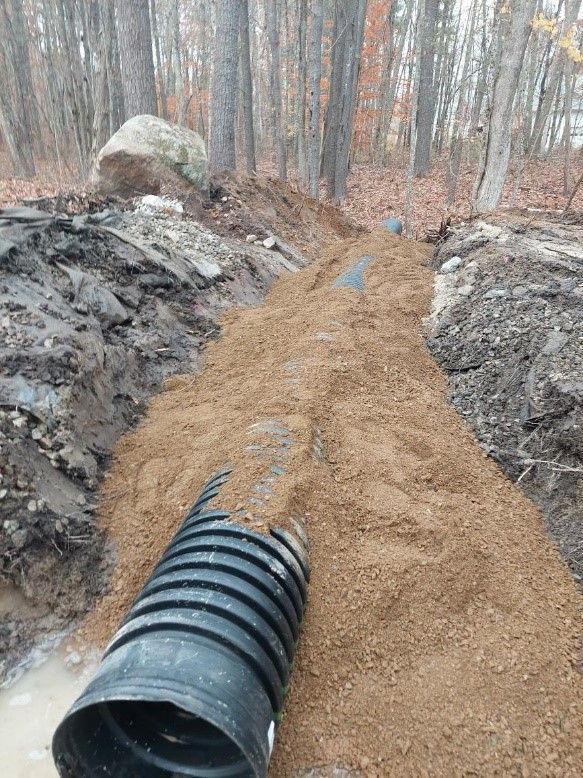Safe and Reliable Tree Removal Solutions
Safe and Reliable Tree Removal Solutions
Blog Article
Culvert Installation Made Easy: Step-by-Step Overview for Success
Installing culverts might look like a straightforward job, but making sure a successful outcome requires careful planning and execution. From picking the proper culvert size to integrating appropriate drainage steps, each action in the installation process plays an essential duty in the functionality and longevity of the culvert system. By complying with a methodical method and paying attention to key details, the setup can proceed efficiently, lessening possible problems down the line. Keep tuned to reveal the vital actions and considerations that can make culvert setup a smooth and effective endeavor.
Choosing the Right Culvert Size
Choosing the proper culvert size is critical for ensuring effective water circulation and architectural honesty in culvert setup jobs - Pad Construction. The size of the culvert straight influences the circulation capability of water via the structure. A culvert that is as well small can result in flooding and overflow, while one that is also huge may lead to reduced water speed, potentially triggering sediment buildup and blockages
To identify the ideal culvert dimension, aspects such as the watershed location, peak flow prices, and hydraulic efficiency need to be thoroughly considered. Calculations based on these criteria assist in choosing a size that can effectively take care of the predicted water volume while reducing the threat of obstructions and structural failure.
It is necessary to speak with engineering guidelines and requirements to guarantee that the chosen culvert size fulfills the job requirements and regional regulations (Pad Construction). By selecting the ideal culvert size, project managers can enhance water flow, avoid possible concerns, and enhance the total performance and durability of the culvert setup
Preparing the Installation Website
Reliable culvert installation necessitates meticulous prep work of the setup website to make sure ideal structural support and functionality. Prior to beginning the installment procedure, it is important to clear the website of any kind of debris, plants, or obstructions that could restrain the culvert's placement.
Additionally, it is necessary to consider elements such as soil make-up, groundwater levels, and environmental impacts when preparing the installment site. Performing a comprehensive site evaluation can help identify any type of possible challenges or dangers that might affect the culvert's efficiency. By taking the time to prepare the installation website correctly, you can assist ensure an effective culvert installment that satisfies structural demands and guarantees original site long-lasting functionality.
Placing the Culvert Appropriately

The grade at which the culvert is positioned is crucial for maintaining an appropriate incline for water flow. In addition, the culvert must be oriented properly to guarantee that the inlet and electrical outlet are in the proper places. Pad Construction.
Backfilling and Condensing the Soil
Proper backfilling and compaction of the dirt around the culvert is crucial to guarantee stability and protect against possible concerns in the future. When the culvert is correctly positioned, the following critical action is to backfill the location around it with suitable material.
Compaction helps in minimizing the possibilities of negotiation and ensures uniform assistance around the culvert. It is important to small the soil uniformly on all sides of the culvert to maintain its architectural honesty.
Proper backfilling and compaction more helpful hints not only supply stability to the culvert yet additionally assist in protecting against soil disintegration and preserving the durability of the culvert system.
Ensuring Correct Water Drainage Combination
Integrating effective drain options plays a vital duty in the overall performance and durability of culvert installations. Proper drain assimilation is necessary for managing water circulation, preventing disintegration, and making certain the architectural honesty of the culvert system. To attain this, it is important to create a comprehensive water drainage plan that considers variables such as the volume of water expected, the topography of the location, and the kind of dirt existing.

Additionally, including features like erosion control actions, such as riprap or plant life, can additionally improve the efficiency of the drainage system. By meticulously intending and carrying out these drainage services, culvert setups can operate effectively and withstand the examination of time.
Final Thought
To conclude, correct culvert installation is vital for keeping effective water drainage systems. By picking the right culvert size, preparing the installation website, positioning the culvert properly, backfilling and compacting the soil, and ensuring appropriate drain assimilation, success can be attained. Adhering to these actions will certainly assist make certain the longevity and efficiency of the culvert, ultimately contributing to the general success of the drainage system.
Report this page